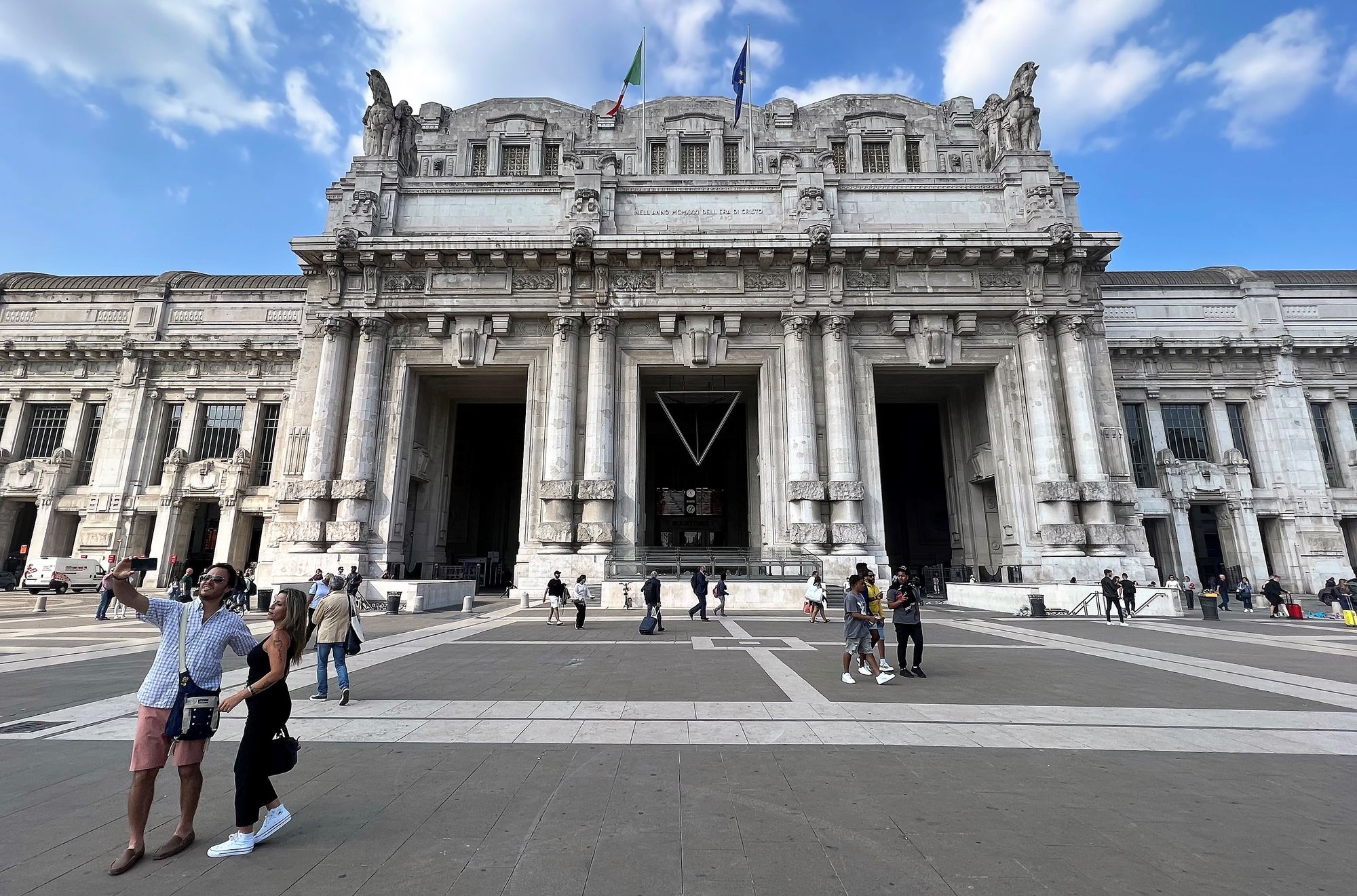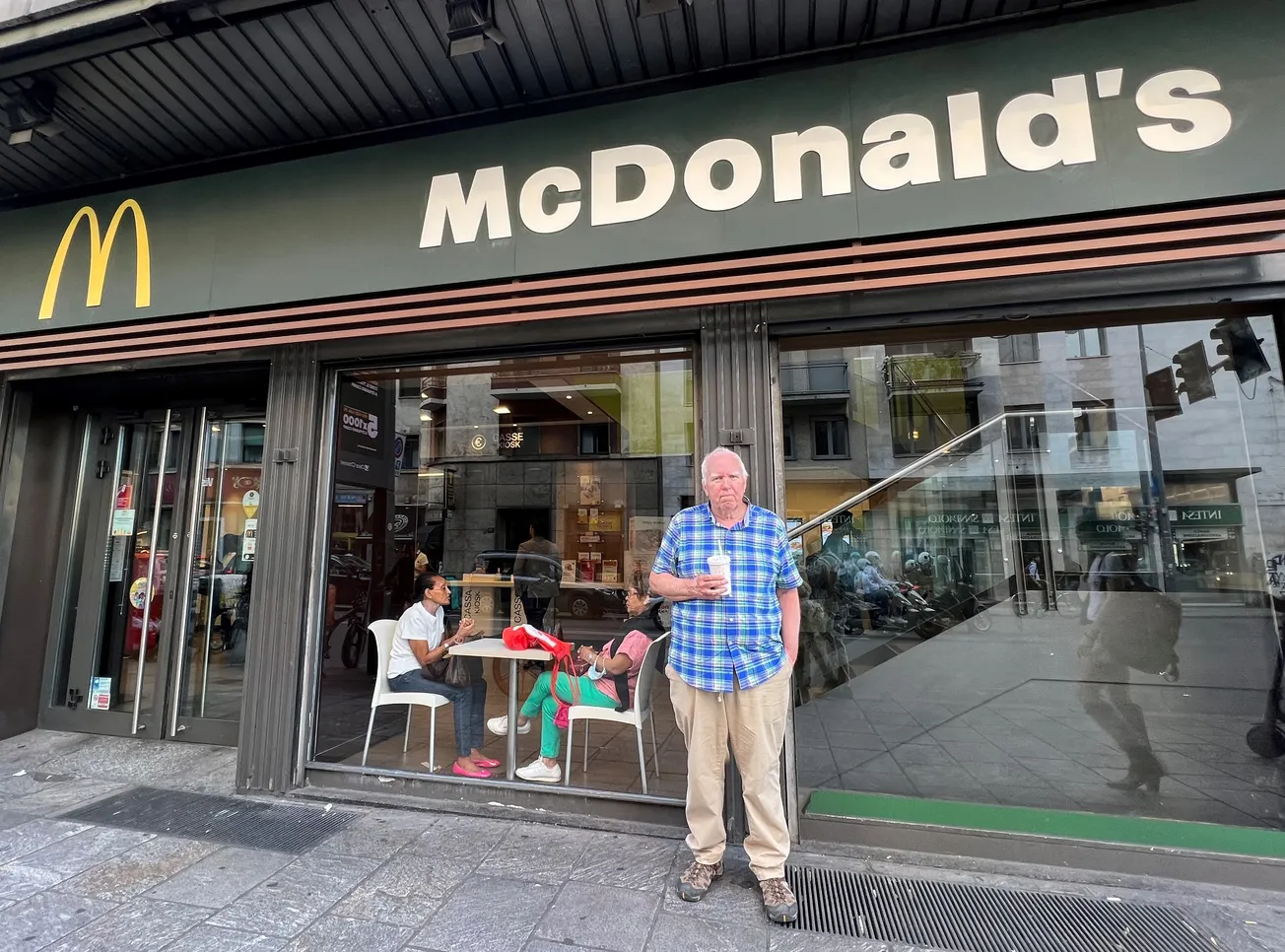I’d bet a Big Mac, super-sized fries, and a large Sprite that few regulars at the Piazzale Loreto McDonald’s know the grisly history of where they chow down.
According to an American travel blogger who goes by “Jeff,” the Milan, Italy, Micky D’s occupies the exact spot where an angry crowd famously abused, then hanged upside down the dead bodies of the notorious Italian dictator Benito Mussolini, his mistress Clara Petacci, and some other Fascist bigwigs on April 29, 1945.
The blog’s headline is a grabber, if a tad misleading: “The Milan McDonald’s Where They Mutilated Mussolini.”
The site was a gas station 78 years ago.
“It may seem sacrilegious to travel all the way to Italy and waste a meal by eating at McDonald’s, but when said McDonald’s was built on the spot where Mussolini’s corpse was defiled by an angry mob, it’s worth sacrificing some flavor for a taste of history,” Jeff explained, adding. “For me, personally, it made my Crispy McBacon even tastier.”
I get it. But we were between meals when we walked under the Golden Arches sign. So I savored a Sprite; Melinda enjoyed a Coke.
I suggested to my spouse that the restaurant should be dubbed “the Mussolini McDonald’s.” She doubted the local manager or stateside McDonald’s corporate execs would agree.
“It’s not my usual policy to condone mob justice, but there are certainly a handful of people in history who have deserved it,” Jeff also wrote.
Amen.
Nothing inside or outside the eatery at Corso Buenos Aires 17 connects it to the padre of Fascism’s inglorious end shortly before World War II ceased in Europe.
Mussolini was “Il Duce” (“the Leader”). But by April, 1945, the leader was a loser.
In 1943, when U.S. and British troops invaded Sicily, his own Fascist government toppled him. Italy abandoned Germany, its partner in perfidy, surrendered to the Allies, and switched sides. Nazi dictator Adolf Hitler sent troops to rescue his abettor, and the Fuehrer put him in charge of a puppet government in northern Italy.
Mussolini knew American and British troops were overcoming stubborn German resistance and advancing northward from Rome, Italy’s capital. But well-armed partisans were an immediate threat to Il Duce. Constantly launching hit-and-run raids against the Germans, they were determined to beat the Allies to him.
Mussolini, 61, opted for flight over fight. He, Petacci, and a small coterie of die-hard Fascists boarded a Luftwaffe truck convoy bound for Germany. Mussolini and Clara hoped to hop off and slip away to neutral Switzerland.
On April 27, partisans ambushed and captured the convoy in the boonies. They promised the fleeing Germans they could skedaddle after surrendering any Italians traveling with them.
The Germans happily agreed.
The partisans reportedly found Mussolini hiding in one of the trucks and wearing a German helmet and overcoat.
The next day, they dispatched the dictator and his paramour with a hail of machine gun fire. The partisans similarly disposed of their Fascist fellow travelers. (According to a possibly apocryphal story, the partisans didn't mean to shoot Clara, but as they took aim at Benito, she flung herself in front of him, apparently thinking they would hold their fire.)

Before dawn on April 29, the partisans loaded the bodies into a van and headed for big city Milan, arriving about 3 a.m. They dumped the bloody, bullet-riddled remains in the piazzale, where 18 months before, some German soldiers had lined up and gunned down 15 anti-Fascist prisoners in retaliation for partisans shooting up a German truck. Near the McDonald’s, a tall stone pillar with a bas relief sculpture of the Christian martyr St. Sebastian honors the men who died for their cause. (Their names are on the back of the pillar.)
We — Melinda, 15-month-old Berry IV and I — had visited Milan in 1994. We tried and failed to find the spot where the crowd strung up Il Duce and Clara.
Jeff had better luck through extensive research. “… Thanks to some historic photos and Google street view I was able to triangulate the location to a bank building on the corner of Piazzale Loreto and Corso Buenos Aires, the ground floor of which is now a McDonald’s. So I knew where I’d be having lunch in Milan when I arrived.”
Aided by Jeff’s blog, we easily found the monument and the McDonald’s last June.
A New York Times reporter who witnessed the gruesome scene called Mussolini’s fate “a fitting end to a wretched life.”
Jeff wrote that by daybreak on April 29, “a crowd had gathered and the bodies were kicked, spat on, urinated on, shot at, hit with hammers, hung upside down from the roof of the nearby Esso gas station, and stoned.
“The motivation was partially revenge, partially a purging of their own guilt for initially supporting Mussolini so enthusiastically, and partially a medieval way to discourage other fascists from continuing to fight. Fittingly, Hitler and [his mistress] Eva Braun committed suicide the following day. It was a good week for anti-fascism.”
Indeed it was.
Footnote 1: Mussolini's rise to power began in 1922 when he ordered his armed Blackshirts to march on Rome from all over the country. While his thugs hoofed it, he took the train from Milan. Italy’s post-World War I constitutional monarchy was weak and chaotic. Mussolini figured the show of force would scare parliament and the king into giving him power. His scheme worked. The king made him prime minister, and Mussolini made himself dictator, brutally crushing all opposition. Eventually, he allied Fascist Italy with Nazi Germany and its dictator Adolf Hitler, whose homicidal hatred of Jews would lead to the murder of six million European Jews.

Footnote 2: Mussolini oversaw the rebuilding of the main train station as a symbol of Fascist might. Called “pompous” and “megalomaniac"-apt descriptors for Il Duce-massive Milano Centrale survived World War II. The multi-columned monstrosity in stone is one of the largest train stations in the world. But like the McDonalds-an easy walk from the stazione ferroviaria-there’s nothing connecting Mussolini’s monumental mix of “Art Nouveau, Art Deco and fascism” to him. (Inside the station is a Holocaust memorial to Italian Jews deported via rail from the city to death camps.)
On our first visit to Milan, I spotted a young man sketching the front of the station. Guessing he might be a fellow Yank, I asked him what he was doing. “I’m in architecture school,” he said. “Where?” “University of Kentucky.”
Footnote 3: Mussolini was buried in an unmarked grave so unregenerate Fascists couldn’t make it a shrine. Turns out, it wasn’t his final resting place.
First, fans found the grave, dug up what was left of their hero and hid him. After government sleuths discovered the remains, they were trundled off to a monastery and finally handed over to Rachele Mussolini, his widow, who was ever faithful to her spouse. When she died in 1979 at age 89, her home was filled with Fascist kitsch.
Il Duce wound up in the family crypt in Predappio, Benito and Rachele’s hometown.
The crypt, according to Jeff, is now a pilgrimage spot for modern day neo-fascists. "Apparently dozens of them visit every day, and every year on the anniversary of his death there’s a fascist march through the nearby town,” he wrote.
Jeff posted his Mussolini blog in 2020. Presumably, visitation is up since Giorgia Meloni became prime minister. Her far-right Brothers of Italy party is rooted in post-World War II neo-Fascism.
“If those jackasses have a site on which to celebrate Mussolini’s life and work, certainly the rest of us should be able to enjoy a Quarter Pounder while quietly celebrating the day that everyone got a chance to spit on his lumped-up corpse,” Jeff proposed.
Now, I’ll drink a Sprite toast to that.
--30--








